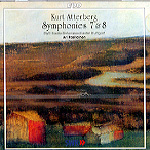The latest installment in CPO’s brilliant Atterberg cycle features the composer’s two wartime symphonies (though neither of them is concerned with war). Symphony No. 7 (1942) draws on themes from Atterberg’s 1932 opera Fanal, which was based on a 16th-century subject. Brass flourishes begin the cinematic first movement (subtitled Drammatico), whose swaggering opening theme leads to a beautifully touching melody based on the opera’s “Slumber Aria”. The wonderfully serene slow movement contains some haunting impressionistic passages, while the finale brings back the vibrant mood of the symphony’s opening.
Atterberg specifically employed Swedish folk melodies as the basis for his Symphony No. 8 (1945). The music is primarily modal and at times sounds like the tone poems of Sibelius, though the orchestral and dramatic style are all Atterberg. (Not surprisingly, Sibelius admired this work.) The symphony exudes an atmosphere of rustic joy in the first movement, and follows with a beautiful, brilliantly elaborated tune in the second, a bright and lively scherzo, and a swirling, folk dance finale. This piece would be a real crowd pleaser and should be in every major orchestra’s repertoire. As we’ve come to expect, Ari Rasilainen and the Stuttgart Radio Symphony give stunning performances, producing a wonderfully robust sound, fully fleshing out Atterberg’s richly colored orchestrations. CPO’s vivid and dynamically true recording is a joy to hear.
































